Carrigaline West
Houses within 10km of this house
Displaying 112 houses.
Houses within 10km of Carrigaline West
Displaying 112 houses.
| House name | Description | |
|---|---|---|
| Vernon Mount | Built by Atwell Hayes in the 1780s, Vernon Mount was the residence of John Leslie in 1814 and of O. Hayes in 1837. Soon afterwards it was leased to William Lane and he was the occupier at the time of Griffith's Valuation, holding the house valued at £55 from Attiwell Hayes. The Hayes sale rental of 1851 describes this house as "a large handsome building erected by the present owner's father at a cost of £5000". It was leased by the Hayes family to William Lane in 1839. A building still exists at this site. | |
| Ballinaboy House | In 1837 Lewis describes this house as a "handsome modern mansion surrounded with young and thriving plantations". John Moloney held Ballinaboy House in fee at the time of Griffith's Valuation, when it was valued at £40. Lewis described it as "a handsome modern mansion, the seat of J. Moloney" in 1837. In the early 1940s the Irish Tourist Association survey described it as being "in a good state of preservation" and occupied by a Mr.Tuttle. It is still extant and occupied. |

|
| Sheep Glen | John H. Wheatley was leasing this property to Michael Roberts at the time of Griffith's Valuation, when it was valued at £7 10s. It is still extant and occupied, situated on a large farm. | |
| Ballinluig | Isaac Seymour was leasing this property to John Smith at the time of Griffith's Valuation, when it was valued at almost £9. This house is no longer extant. | |
| Arlinstown House | James Gillman was leasing Arlinstown House to Thomas Richardson Leane at the time of Griffith's Valuation, when it was valued at £15. A house and extensive farm buildings are extant at this site now. | |
| Ballindresrough Mills | William R. Meade was leasing this property to Daniel Keller at the time of Griffith's Valuation, when it was valued at £25, including a flour mills. It is not marked on the later 25-inch map, suggesting it was no longer operational in the 1890s. Extensive farm buildings occupy the site now. | |
| Ballymartle | William R. Meade held Ballymartle in fee at the time of Griffith's Valuation, when it was valued at £35. It was also noted by Lewis as the seat of W.R. Meade in 1837. In the 1770s it was the property of Rev. W, Meade. In the 1940s the Irish Tourist Association Survey described it as "an imposing residence in a finely wooded estate, occupied by Major Meade". It is now a roofless ruin. |

|
| Mill-Land | William Meade was leasing this property to Thomas R. Leane at the time of Griffith's Valuation, when it was valued at almost £9. | |
| Mullagh or Rock Hill House | William R. Meade was leasing this property to Thomas R. Leane at the time of Griffith's Valuation, when it was valued at £8 10s. It is labelled as Rock Hill House on the 6-inch Ordnance Survey map but appears on the 25-inch map of the 1890s as Mullagh House. A possibly later house and large farm occupy the site now. | |
| Coolkirky | The representatives of Gresham Herrick held this property in fee at the time of Griffith's Valuation, when it was valued at £25. The house burned down in the late 1990s. | |
| Stonehill House | Henry Busteed was leasing Stonehill House from William B. Warren and others at the time of Griffith's Valuation, when it was valued at £11 10s. A smaller house in the same townland, also owned by Warren and known as Maryville [W725608], was valued at £8. It was occupied by Robert Condron at that time. Neither of these houses are extant now. | |
| Glinny House | George Dunne was leasing Glinny House from Thomas Daunt at the time of Griffith's Valuation, when it was valued at £25. Lewis refers to it as the seat of G.N. Dunne in 1837. The Daunt family also owned Glinny Cottage [W669595] in the same townland, then valued at £8 and occupied by Elizabeth Walsh. Though altered Glinny House is still extant. |
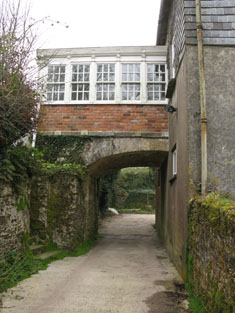
|
| Heathburn Hall | George Daunt held this property in fee at the time of Griffith's Valuation, when it was valued at £35. The National Inventory of Architectural Heritage notes that it was later associated with the Shaw familiy who made additions to the house in the early twentieth century. In the 1940s the Irish Tourist Association Survey noted it a the residence of Mr. Bateman. There is still an extant property at the site. | |
| Ballindeenisk House | Mrs. Charlotte Harrison held this property in fee at the time of Griffith's Valuation, when it was valued at £8. It is one of two houses labelled Ballindeenisk House on the 1st edition Ordnance Survey map and it also appears under this name on the later 25-inch edition of the 1890s. It is no longer extant. | |
| Fountainstown | Francis Hodder was leasing this property to George Hodder at the time of Griffith's Valuation, when it was valued at £24. In 1837 Lewis referred to Fountainstown as the seat of G. Hodder. Local sources indicate that this house originally belonged to the Roche family whose lands the Hodders were granted and that the oldest part of Fountainstown House was the original Roche property. In the 1940s the Irish Tourist Association Survey noted that it was listed in the Association's directory of hotels. Fountainstown is still extant and occupied. |

|
| Gortigrenane House | At the time of Griffith's Valuation, this house was being leased by Anthony Savage from the Staughton estate, when it was valued at £40. Lewis refers to it as the seat of Luke Shea in 1837. Thomas A. Staughton owned a second property in this townland [W777575], valued at £10 and leased to David Drinan. Gortigrenane had originally been a Daunt property, which came to Staughton through marriage with Mary Daunt, of Owlpen, Gloucestershire. It is believed to have been remodelled in 1817. See www.owlpen.com. The house was destroyed during the War of Independence. In 1942 the Irish Tourist Association Survey described it as formerly the residence of L. Shea, "a noted smuggler" and then in the possession of the Kingstons. It is now a ruin. |
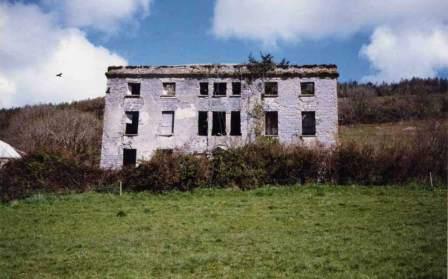
|
| Broomley | George Daunt was leasing Broomley from Reverend Thomas Townsend at the time of Griffith's Valuation, when it was valued at £18. Lewis refers to it as his seat in 1837. In 1942 the Irish Tourist Association Survey also noted it as a residence of the Daunt family. It is now a ruin. | |
| Willowhill House | Edward R. Warren was leasing Willow Hill House to Thomas Hungerford at the time of Griffith's Valuation, when it was valued at £13. It is still extant and occupied. |
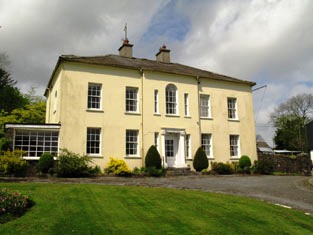
|
| Old Castle (Tracton) | Achilles Daunt was leasing this property to Bartholomew Coveney at the time of Griffith's Valuation, when it was valued at £10. A house and extensive farm now exist at the site. | |
| Ringabella | Samuel Hodder held this property in fee at the time of Griffith's Valuation, when it was valued at £25. Lewis refers to it as the seat of S.A. Austin in 1837. In 1942 the Irish Tourist Association Survey noted that had been a residence of the Austins but was then owned by the McCarthy family. Ringabella is still extant and occupied. | |
| Springhill House | William Daunt was leasing this property from William H. Daunt at the time of Griffith's Valuation when it was valued at £17 and included coal stores. It is still extant and in use. |
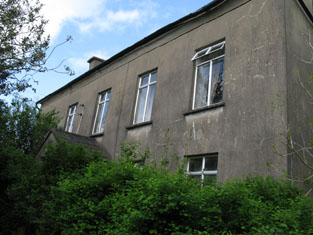
|
| Tracton Cottage | Achilles Daunt was leasing this property to Richard Hungerford at the time of Griffith's Valuation, when it was valued at £7. A house still exists at the site. | |
| Tracton Abbey | Denis Coveney was leasing this property from Achilles Daunt at the time of Griffith's Valuation, when it was valued at almost £9 with an adjacent mill valued at £11. Buildings are still extant at the site. | |
| Fivemilebridge Mill House | Joseph Coghlan was leasing this property to William Herrick at the time of Griffith's Valuation, when it and the adjacent mill were valued at £53. The mill buildings are no longer visible on the 25-inch map of the 1890s. The house is still extant. |
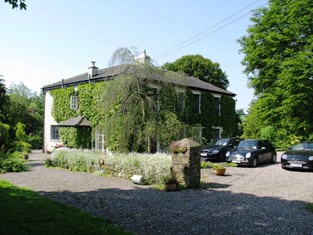
|
| Ballybricken House | Described by Lewis in 1837 as "the elegant mansion and demesne of D.Connor". It was held in fee by him at the time of Griffith's Valuation when it was valued at £64. The residence of Captain Denis Connor in 1894. In 1943 the Irish Tourist Association Survey mentions it as the residence of J.E. Bird, the walls built in 1820 but the interior having been restored following a fire in 1910. The Survey also notes that it was used as a base by the American navy during the first World War. The site is now covered by industrial premises. | |
| Prospect Villa | Thomas Burke was leasing Prospect Villa from Mary and Catherine Rogers at the time of Griffith's Valuation, when it was valued at £60. Lewis refers to it as the seat of Lt.Col. Burke in 1837. The house was included in the sale of the Rogers estate in the Landed Estates Court in February 1862. In 1943 the Irish Tourist Association Survey noted Prospect Villa as the residence of G. Hosford and outlined Burke's association with the house mentioning that he kept a racing stable there. The house is no longer extant and a factory has been constructed in this area. | |
| Castlewarren | Robert Warren was leasing this property from Mary and Catherine Rogers at the time of Griffith's Valuation, when it was valued at £35. In 1837 Lewis referred to it as a "spacious mansion erected in 1796, the seat of R. Warren". Townsend refers to it as the seat of Thomas Warren "whose style of farming is conducted on the best principles of modern art". It was included in the sale of Warren's estate in October 1850. Now a ruin. | |
| Rock Cottage (Barnahely) | William Warren was leasing this property to Richard Foott at the time of Griffith's Valuation, when it was valued at £11 5s. A house is still extant at the site. | |
| Myrtle Hill | Richard Barter was leasing this house to Denis Ahern at the time of Griffith's Valuation, when it was valued at £12. Myrtlehill Farm is still extant at the site. | |
| Ballygarvan House | Joseph B. Coghlan held this property in fee at the time of Griffith's Valuation, when it was valued at £30. It is still extant. | |
| Wood View [Carrigaline] | George Daunt was leasing this property to William Daunt at the time of Griffith's Valuation, when it was valued at £7. A house is still extant at the site. | |
| Fahalea | Thomas Daunt held this property in fee at the time of Griffith's Valuation, when it was valued at £10. Extensive farm buildings exist at the site now. | |
| Ballynametagh | At the time of Griffith's Valuation, John Kingston was leasing this house to Daniel Coates, when it was valued at £9. A modern house and farm occupy this site now. | |
| Waterpark | This was a Lavallin home in the 18th century. Robert Atkins leased this property from the representatives of Thomas Dorman/Dormand at the time of Griffith's Valuation. It was valued at £48. | |
| Mount Rivers (Carrigaline) | Michael Roberts was leasing Mount Rivers from the representatives of Daniel Morrison at the time of Griffith's Valuation, when it was valued at £45+. The sale rental of 1863 records Michael Hodder Joseph Roberts as the tenant of Mount Rivers. The house is still extent and the National Inventory of Architectural Heritage states that it is still owned by the Roberts family. |

|
| Ravenswood or Monroe House | Michael Roberts was leasing this property to Ralph Westropp at the time of Griffith's Valuation, when it was valued at £38. On the 1st edition Ordnance Survey map it is labelled Monroe House but later came to be known as Ravenswood House. Monroe House appears at a different location (W715627) on the 25-inch Ordnance Survey Map of the 1890s. Ravenswood was occupied by the Westropp family until the twentieth century. |

|
| Beaver Lodge & Carrigaline Mill | Michael Roberts was leasing this property from Michael O'Brien at the time of Griffith's Valuation. It included a mill and was valued at £100. Buildings at this site appear to have been demolished in the first decade of this century. | |
| Commeen | Thomas Hayes was leasing this property to Richard Hayes at the time of Griffith's Valuation, when it was valued at £8, on a holding of 230 acres. On the 25-inch Ordnance Survey map of the 1890s it is labelled Commeen Kennels. Farm buildings still exist at the site. | |
| Coolmore | Held in fee by Reverend Edward H. Newenham at the time of Griffith's Valuation, when it was valued at £100. He was leasing a smaller house, valued at £8, to John Donegan in the same townland. Noted by Leet as the residence of W.W. Newenham in 1814. Valued at £64 in 1906 when it was the residence of Major William W. Newenham. The Irish Tourist Association Survey also noted it as belonging to the Newenhams in 1943. It is still extant but in poor repair. |
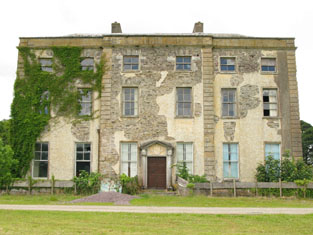
|
| Shanbally Cottage (Carrigaline) | Thomas Burke was leasing this property to Joseph Beaumont at the time of Griffith's Valuation. It was valued at £34 and included a mill. The latter, known as Rathanallig Mills (W751651), is described as "in ruins" on the 25-inch Ordnance Survey Map of the 1890s while the house is diminished in size and has since disappeared. There are still buildings on the mill site. | |
| Killanully | Rev. Edward Newenham was leasing this property to Michael Donegan at the time of Griffith's Valuation, when it was valued at £9. | |
| Kilmoney Abbey | At the time of Griffith's Valuation, Michael Roberts was leasing this property from Thomas R. Sarsfield, when it was valued at £50. Lewis referred to it as the "handsome residence" of Michael Roberts in 1837. It is stil extant and well maintained. Thomas Sarsfield was leasing a smaller propertyin the same townland, valued at £9, to Eugene McCarthy. There are two properties shown on the 25-inch Ordnance Survey map of the 1890s, Kilmoney House and Kilmoney Cottage. Buildings are still extant at these sites though extensive urban development has occurred in the area. |

|
| Ballea Castle | Francis Hodder held this property in fee at the time of Griffith's Valuation, when it was valued at £24 10s. Lewis also refers to it as his seat in 1837. Local sources suggest that It was originally built by the McCarthy family and later acquired by the Hodders. In the 1940s the Irish Tourist Association survey refers to it as being occupied by F. Dorman, retired engineer, and that it was the oldest occupied castle in Éire. Though much altered over the years, it is still extant and occupied. |

|
| Ballea Mill | Thomas Hewitt was leasing this property to Thomas Sullivan at the time of Griffith's Valuation, when it was valued at £20, including the adjacent mill. The latter property is labelled "in ruins" on the 25-inch Ordnance Survey map of the 1890s. | |
| Ballea A | At the time of Griffith's Valuation, Thomas Hewitt was leasing this property to Shaw Busteed, when it was valued at almost £10. Buildings are still extant at the site. | |
| Raffeen House | Robert Hedges White held this property in fee at the time of Griffith's Valuation, when it was valued at £42. It was the home of his wife's family, Charlotte Mary Dorman. In 1837 Lewis referred to it as the seat of T. Dorman. The property is still extant. |

|
| Raffeen Cottage | Robert White was leasing this property to Sarah Phillips at the time of Griffith's Valuation when it was valued at £12 5s. It appears on the 25-inch Ordnance Survey map as Raffeen Cottages, indicating the presence of more than one dwelling. The buildings are still extant. | |
| Raffeen House [Lower] | William Drinan was leasing this property from the White estate at the time of Griffith's Valuation, when it was valued at £13 10s. The site is now occupied by industrial premises. | |
| Shanagraigue | Richard Woodley held this property in fee at the time of Griffith's Valuation, when it was valued at £13 10s. Buildings are still extant at the site. | |
| Ardmore House | Richard Roberts held this property in fee at the time of Griffith's Valuation, when it was valued at £55. Lewis refers to is as the seat of J. Roberts in 1837. In 1943 the Irish Tourist Association Survey mentions it as the birthplace of Lieutenant Richard Roberts, Master of the ship, Sirius, the first steamship to cross the Atlantic. Ardmore is still extant and occupied. | |
| Aghamarta Castle | This property was held in fee by the representatives of Carew O'Grady at the time of Griffith's Valuation, when it was valued at £22. Lewis noted it as the seat of Carew O'Grady in 1837. Local sources suggest that he had purchased it, c.1824, from the Pomeroy family, who had purchased it from the Earl of Shannon in the later seventeenth century. The original castle was replaced by the existing house in the 1830s. The property is now a farm and cookery school. See www.thompsonsfarmshop.com |
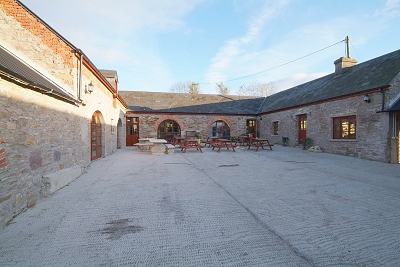
|
| Crosshaven House | Thomas Hayes held this property in fee at the time of Griffith's Valuation, when it was valued at £44. Lewis refers to it as the seat of T. Hayes in 1837. Local sources suggest it was built in the eighteenth century replacing an earlier house. It remainded in the ownership of the Hayes family until the early 1970s. The house is still extant and occupied and sometimes open to the public. |
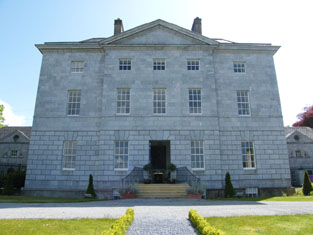
|
| Point House (Crosshaven) | Edward Sisk was leasing this house from the Puxley estate at the time of Griffith's Valuation, when it was valued at £10 10s.The house at the site is known as Point House and the National Inventory of Architectural Heritage suggests it was built in the mid-eighteenth century. |

|
| Hoddersfield | Lewis refers to Hoddersfield as the seat of Col. Hodder in 1837 and held in fee by William H. Hodder in 1850. The house was then valued at £95. In 1894 Slater referred to it as the seat of William Hodder. In the 1940s the Irish Tourist Association noted that it was the residence of B Nicholson, who had bought the property from the Hodders and that the Library and other Hodder materials remained intact at the house. Hoddersfield is now a roofless ruin. |

|
| Myrtleville Cottage | Ó Murchadha states that Myrtleville Cottage was built by Sir Nicholas Trant in the early nineteenth century and was later sold by him to Joseph Cummins. At the time of Griffith's Valuation, this property was unoccupied but owned by several parties including Cummins as well as the Daunt and Puxley estates. It was then valued at £11. It is still extant and has sometimes operated as a bar and restaurant. |

|
| Myrtleville House | Lewis refers to Myrtleville House as the seat of Dr. Shea. This was Dr William Augustine Shea or O'Shea, brother of Luke Shea of Gortigrenane. By 1850 it was being leased by James Fegan from the Puxley estate among others and was valued at £25. Ó Murchadha notes that it had earlier been owned by the Trant family and had a suceession of owners since including several periods of occupation by members of the Daunt family. It is still extant. |

|
| Mount Mary | W. Fortune was resident at Mount Mary in 1837. The house was valued at £28 and occupied by Daniel Lombard at the time of Griffith's Valuation. It was held from William Austin. A house is still extant at the site. | |
| Seamount House (Carrigaline) | Louisa Penrose, with several others, was leasing this property to James French at the time of Griffith's Valuation, when it was valued at £12. Henry Smith was leasing a property [W785625] valued at £10 from the same estate, also in Curraghbinny townland. In 1860, over 600 acres owned by members of the Fitzgerald family and others were offered for sale in the Landed Estates Court. The sale included Seamount House, in the possession of Henry Smith. | |
| Hilltown House (Carrigaline) | Hilltown House was leased by Thomas Busteed from Anne Cook at the time of Griffith's Valuation, when it was valued at £8. It is labelled as Hilltown House on both the 6-inch and 25-inch Ordnance Survey maps. | |
| Marino | The present house was built on the foundations of an earlier house which was burnt in the 1860s. Wilson refers to this earlier house on Great Island as the seat of Savage French in 1786. Marine remained the home of a branch of the French family and sold by Colonel Stuart French in the early 1970s. The National Inventory of Architectural Heritage entry states that this house was previously the home of the mathematician Philip Ronayne. Valued at £32 in the early 1850s it was occupied by Thomas G. French who held the property from Thomas R. Sarsfield. Knight writes that Thomas Sarsfield of Doughcloyne leased the lands of Ronayne's Grove, otherwise Hodnet's Wood, otherwise Marino to Savage French in 1755. Thomas G. French is also recorded as the occupier in 1814 and 1837. |

|
| Carrigrenan | Occupied by J. M. Ashlin (father of the architect George Ashlin) in 1837 and by the Reverend Robert Bury in the early 1850s. He held the house valued at £37 from Warren H. R. Jackson. The home of the Sullivans in the 20th century. | |
| Little Island House | A Bury residence, occupied by Richard Bury in 1814, by Phineas Bury in 1837 and by his widow Eliza at the time of Griffith's Valuation. The house was valued at £51 and held from the Earl of Limerick. Bence Jones wrote n 1978 that the house was a ruin and the site is now occupied by industrial buildings. | |
| Flaxfort | Occupied by R. Martin in 1837 and by Mary Anne Martin at the time of Griffith's Valuatioan. The house was valued at £21 and held from John Purcell. It is no longer extant. |
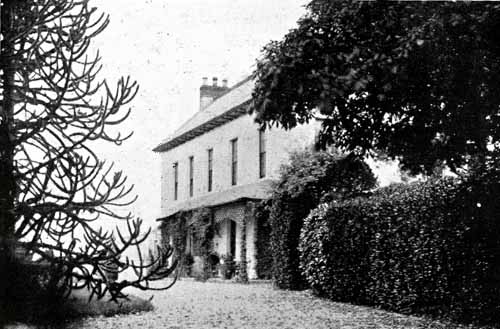
|
| Inchera | This house, also known as Sun Lodge, was the home of the Oliver family. Occupied by S. Oliver in 1814 and Silver Charles Oliver in 1837 and in the 1850s. The buildings were valued at £54 and the property was held from the Reverend Rowland Davis Gray. Owned by C.E. Murphy in the first half of the 20th century. Post 1950 it was destroyed by a fire. | |
| Ballynoe House | A house occupied by Abraham Hargreave in 1837 and at the time of Griffith's Valuation, held from James H.S. Barry and valued at £14.15 shillings. Abraham Hargrave owned 36 acres at Ballynoe in the 1870s. Later owned by the Murphy family. This house is still extant and occupied. |

|
| Monkstown Castle | Built by a Mrs Archdeacon in the 17th century, Monkstown Castle was the home of the Shaw family in the 19th century and held from the de Vesci family. In the early 1850s Robert Bernard Shaw was resident and the buildings were valued at £54. In the possession of the Monkstown Golf Club for much of the 20th century, Further information on the building's construction is available at https://www.logainm.ie/ga/9588. |
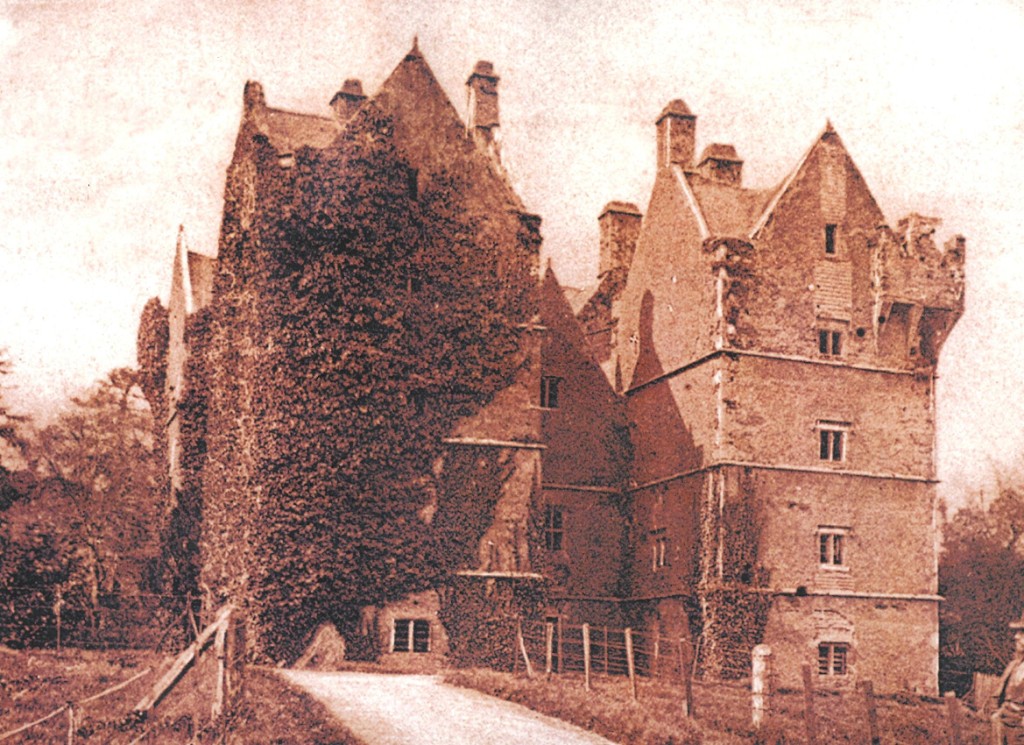
|
| Waterview (Passage West) | Leased by Richard Neville Parker from Lord deVesci's estate at the time of Griffith's Valuation when it was valued at £76. Waterview was offered for sale in the Landed Estates Court by Parker's widow, Hannah Maria, in September 1874. Waterview is still in use as a residence. | |
| Bellevue (Passage West) | In 1850, Nicholas Parker was leasing this property from the deVesci estate when it was valued at £33 10s. It is shown on the 25-inch Ordnance Survey map of the 1890s in a much enlarged form but was subsequently demolished to make way for the terrace of houses which now occupies the site. | |
| Ring View | Ring View was being leased by Robert Baily from the deVesci estate at the time of Griffith's Valuation, when it was valued at £18 10s. A house is still extant at the site. | |
| Rock Cottage (Passage West) | Catherine Parker was leasing this property from Thomas Boland in 1850 when it was valued at £36 10s. A house is still extant at the site. | |
| Lackaroe House | In 1850, Catherine Anne Parker was leasing this property to Cornelius Hawkes when it was valued at £21. A house still exists at this site. | |
| Rock Ville (Passage West) | Mrs. Anne Taylor was leasing Rock Ville from the Parker estate at the time of Griffith's Valuation, when it was valued at almost £25. Lewis refers to it as the seat of J. Taylor in 1837. It is still extant and occupied. |

|
| Rockenham | In 1850 Thomas Parsons Boland was leasing this house to Noble Johnson, when it was valued at £100. Lewis refers to it as Johnson's seat in 1837. The National Inventory of Architectural Heritage suggests it was built by the Johnsons in the 1820s. It is still extant and occupied. |
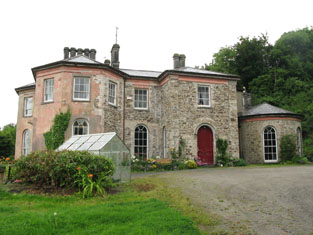
|
| Pembroke | The seat of Thomas Parsons Boland in 1837. Held in fee by him at the time of Griffith's Valuation, when it was valued at £48. Pembroke, together with many other of his houses, was included in the Sale Notice of Boland's estate in November 1859. It was offered for sale again in May 1868 when the house was noted as having "lofty and spacious rooms". In 1786 Wilson refers to Pembroke Town as the seat of Mr. Boland. In 1943 the Irish Tourist Association Survey noted that the Duke of Wellington was supposed to have stayed at Pembroke prior to embarking for the Peninsular wars. The house is no longer extant and a housing development has been built on the site. | |
| Horsehead | In 1850, Horsehead was being leased by James Craig from William Lane and was valued at £60. In November 1859 it was offered for sale as part of the Boland estate. Lewis refers to it as the seat of S. Lane in 1837, "an elegent mansion in the Tudor style". In 1943 the Irish Tourist Association Survey noted that the horses of the Duke of Wellington's cavalry had grazed on the front lawn at Horsehead prior to embarking for Europe. It is still extant and occupied. It was offered for sale in 2024. |
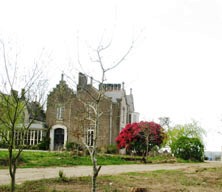
|
| Horsehead Cottage | Held from Thomas Boland's estate by Samuel Abbott in 1850 when it was valued at £38 10s. It was included in the sale of the estate in November 1859. It is no longer extant. | |
| Maryborough | In 1786 Wilson refers to Maryborough as the seat of Mr Newnhan and it was also a Newenham home in the 19th century, occupied by R. Newingham in 1814, by Edward Eyre Newenham in 1837 and at the time of Griffith's Valuation. He held the property in fee and the buildings were valued at £80. Thomas Sherrard held a mansion house valued at £61 in this townland in 1906. It is now part of a large hotel complex. |
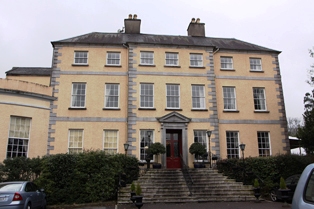
|
| Doughcloyne | Originally the home of the Ronayne family, it passed by marriage to the Sarsfields. Occupied by Dr Sarsfield in the 1770s and 1780s, by Mr Haynes in 1814, by D. Sarsfield in 1837 and by Thomas R. Sarsfield in the early 1850s, who held it in fee, value £43. In 1894 Slater notes it as the seat of Capt. T.R. Sarsfield. This house is no longer extant. | |
| Oldcourt | Oldcourt was the seat of the Goold family baronets until 1852 when it was bought by Alexander Glasgow. The sale rental of March 1852 includes a lithograph of Oldcourt. Griffith's Valuation records Glasgow holding the property in fee and the buildings were valued at £68. The Glasgows leased the house until it was bought in the early 20th century by Henry O'Shea although Alexander J. Glasgow is recorded as the occupier in 1906 when it was valued at £51. Henry O'Shea sold it to the Brothers of Charity in 1934 whose services used it as a Special Needs school. It is still extant. |
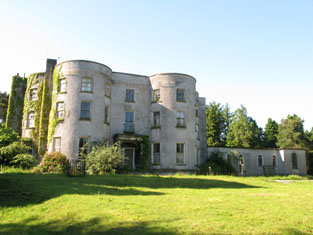
|
| Montpellier | A house occupied by the Reverend Morgan O'Donovan in 1837 and by Morgan O'Donovan in the early 1850s. The house was held in fee by the O'Donovans and was valued at £55. There is no trace of this house now as modern development has taken place in the area. | |
| Castle White | Occupied by Whyte Esq in the 1770s Wilson refers to this property as Rochfordstown in 1786. George M. White was the owner in 1837 and held by him in fee at the time of Griffith's Valuation when the house was valued at £35. Lucia P. Hawkes was recorded as the occupier of two mansion houses in this townland in 1906, one valued at £27 and the other at £53. Castle White is still extant. In 2023 it was offered for sale by Sothebys International. |
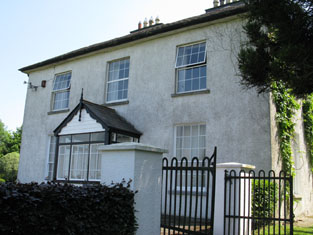
|
| Chetwynd | The Pigotts were established at Chetwynd in the early 18th century and Wilson refers to it as their seat in 1786. By the end of the century they were resident in county Laois. In 1837 J. Forrest was the proprietor of Chetwin and in the mid 19th century William Bateman occupied the house, valued at £25, which he held from John Dennis. Two houses are marked on the first Ordnance Survey map for Chetwynd. It is not clear which one was the Pigott house. | |
| Willsfort | Occupied by William Harris in 1814 and by Mrs Dowman in 1837. Francis Clancy was the occupier at the time of Griffith's Valuation holding the house valued at £26 from Jane Dowman. A house is still extant at the site. | |
| Lotabeg | Bence Jones writes that this house was built circa 1800 for Sir Richard Kellett 1st Baronet. Lewis gives D. Callaghan as the proprietor of Lotabeg in 1837. Poole Hickman was resident at the time of Griffith's Valuation, holding the property from William Galway. The buildings were valued at £87. Home of the Mahony family in the late 19th century. | |
| Ballincurrig | W.C. Logan occupied Ballincurrig Cottage in 1837 and William Coppinger occupied a house at Ballincurrig valued at £33 and held by him in fee at the time of Griffith's Valuation. | |
| Cleve Hill | Samuel Perrott was residing at Cleve Hill in 1837 and in the early 1850s when the house was valued at £68 and held from Alexander McCarthy. Cleve Hill a modern family mansion on 13 acres was advertised for sale in October 1873, the estate of Joseph Gadsden Nash and Arthur Power Harty, bankrupts. | |
| Clifton | John Moore Travers inhabited this house in the first half of the 19th century. At the time of Griffith's Valuation Clifton was valued at £65 and held from the Earl of Bandon. John M. Travers only child Elizabeth married in 1827 Sir William Henry St Lawrence Clarke, Baronet. Later the home of Nicholas Murphy and in the 20th century in use as a convent. | |
| Besborough | In the 1770s the residence of Allen Esq. The seat of the Pike family for most of the 19th century. Occupied by J. Spence in 1814 and by Ebenezer Pike in 1837 and in the early 1850s. He held the property from the representatives of Bousfield and the house was valued at £78. This house was used as a convent in the 20th century. http://www.askaboutireland.ie/reading-room/history-heritage/big-houses-of-ireland/bessborough-house-and-est/index.xml | |
| Hampstead | The residence of G. Britton in 1814 and of Lieutenant Boyle Hill in 1837. Occupied by John H. Bainbridge at the time of Griffith's Valuation. He held the property in fee and the house was valued at £22. The house is not labelled on the 25-inch Ordnance Survey map of the 1890s and is no longer extant. | |
| Frankfield | Located on the side of what is now the Frankfield Golf Club, Frankfield House was occupied by S. Lane in 1837 and by the Very Reverend H. J. Newman in the mid 19th century. Reverend Newman held it from William Lane and the buildings were valued at £60. | |
| Castlemahon | Seat of the Chatterton family, occupied by Sir James Chatterton in 1814 and Sir William in 1837 and at the time of Griffith's Valuation when it was valued at £47. The property was held from the Ecclesiastical Commissioners. The building now houses a youth centre run by the Redemptorist Order. |
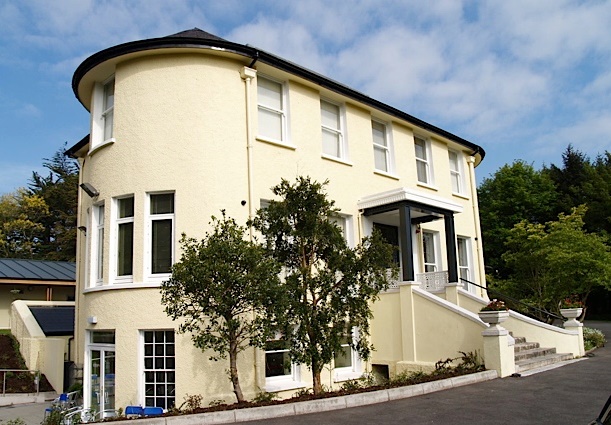
|
| Ferney | Ferney was the residence of Mrs Coote in 1814 and of J.H. Manley in 1837. Joseph Manly occupied the house valued at £68 at the time of Griffith's Valuation. He held it from Sir William Chatterton. This house is still extant. | |
| Lakeview | Occupied by Miss Allen in 1837 and by William Prittie Harris in the early 1850s when the house was valued at £28 and held from Sir William Chatterton. In the 1870s Richard Harris of Lakeview, Cork, owned 169 acres. This house no longer exists. | |
| Ringmahon Castle | The proprietor of Ring Mahon Castle in 1837 was J. Murphy. James Murphy occupied the house valued at £68 in the early 1850s and held the property from William Crawford who held from the Chattertons by lease dated 1797. This property was still in the possession of the Murphy family at the end of the 19th century. | |
| Dundanion Castle | The residence of the architect Sir Thomas Deane in 1837, valued at £78 in the early 1850s and held from Richard Sampson. Sold by Sir Thomas to William Wise in 1860 and by Wise to William Thornton in 1868. A residence is still extant at this site. | |
| Garrane | In the early 1850s Francis Hennis occupied a house valued at £30 from William Howe Hennis. A building still exists at this site. | |
| Grange | H. Conron occupied Grange in 1837 and at the time of Griffith's Valuation when the buildings were valued at £40 and held from J.D.C. Beamish. Hatton Condon was still living at Grange in the 1870s. In 1894 Slater records Grange as the seat of E.R. Conron. This house no longer exists. | |
| Lehenaghbeg | A house valued at £14 in the mid 19th century and held by Edward Casey from James H. S. Barry. Edward Casey was the owner of 121 acres at Lehenaghbeg in the 1870s. | |
| Lehenagh | Occupied by T. Curtis in 1837. By the early 1850s Mary Curtis was resident holding the house valued at £28 from the Reverend Edward H. Newinham. | |
| Lehenagh House | A home of a member of the Newingham family in 1814 and of Charles Mathew in the mid 19th century.James Mathews of Lehenagh owned 107 acres in the 1870s. This house no longer exists. | |
| Ashton | A house occupied by John Cotter from at least 1814 until his death in 1864 and by Mrs Catherine Cotter until at least 1871. It is not clear if John Cotter was a member of the Cotter family, baronets. The house is now part of the Ashton School complex. | |
| Charlemont House | Charlemont House was leased by Charles Evanson from Nicholas G. Allen at the time of Griffith's Valuation, when it was valued at £20. It was included in the sale of Evanson property in the Landed Estates Court in November 1862. It is still extant. | |
| Woodhill | Originally this property belonged to the Dennis family. Following the marriage of Elizabeth Dennis to Cooper Penrose, a Quaker, of Waterford, it passed into the possession of the Penrose family, who enlarged the house. Another Cooper Penrose was the occupant in 1814 and in the mid 19th century holding the property from James Murphy. The buildings were valued at £100. The house was demolished circa 1980s. | |
| Parkgarriff | This house was the home of at least two generations of David Cagneys in the 19th century. The house was valued at £40 at the time of Griffith's Valuation and held by David Cagney from Lord de Vesci. The Cagneys were still resident in the 1870s. The house no longer exists and the site is located on the edge of the Monkstown Golf Club. | |
| Ballindeasig | Substanial buildings are marked at the site of Ballindeasig House on the first Ordnance Survey map and at the time of Griffith's Valuation the house valued at £18 was occupied and held by Richard Kenefick in fee. Ballindeasig was conveyed to John C. Hennessy by Richard Kenefick in 1853. It was the home of Michael Hennessy in the late 19th century and was left by Miss Minnie Hennessy to Bishop Cohalan of Cork in 1937. The house was then converted into a holiday home for the Sisters of Mercy Order. Now known as Tabor Lodge it is a centre for the treatment of substance abuse. see www.taborlodge.ie/ |
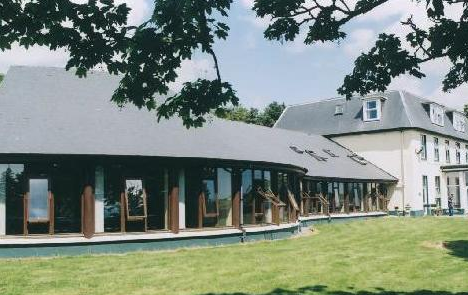
|
| Wilton | In 1786 Wilson refers to "Willtown" as the seat of Mr. Izod. Charles H. Leslie occupied Wilton in 1814 and in 1837. By the mid 19th century Matthew Leslie was resident, holding the house valued at £55 from John Craig and H. Mitchell. A college is now located at this site. | |
| Seamount House (Carrigaline) | At the time of Griffith's Valuation, this property was leased by James French from the Penrose estate when it was valued at £12. The property is labelled Seamount House on the 25-inch Ordnance Survey Map of the 1890s. There is still an extant house at this site. | |
| Curraghbinny | In 1850 Henry Smith was leasing this property from the estate of Louisa Penrose and others, when it was valued at £10. It is not shown on the 25-inch map of the 1890s. | |
| Green Mount (Passage West) | Robert Hodgson was leasing Greenmount from the Boland estate at the time of Griffith's Valuation, when it was valued at £19. It is still extant and occupied. |
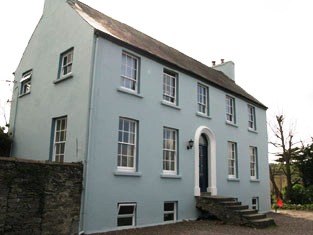
|
| Mansfield (Passage West) | At the time of Griffith's Valuation, William Browne was leasing this property from the Boland estate, when it was valued at £56. It is still extant. | |
| Mounthovel House | In 1786 Wilson refers to Mounthovel as the seat of Mr. Farmer. At the time of Griffith's Valuation, Mout Hovel House was occupied by Edward Newenham leasing from the Atkins estate and valued at £8. It is no longer extant and the area is now occupied by modern housing. | |
| Hop Island | At the time of Griffith's Valuation, Osborne Edwards was leasing this property from the Chatterton estate when it was valued at £16. It is labelled Hop Island on both the 1st and 25-inch edition Ordnance Survey maps. This may be the property referred to by Wilson as Red Island, the seat of Rev. Mr. Saunders, in 1786. A house is still extant at the site. |

